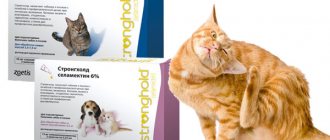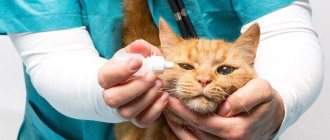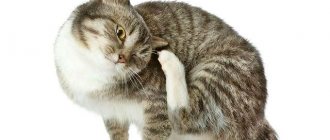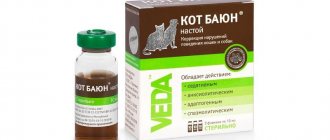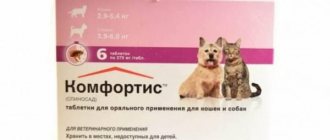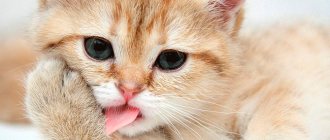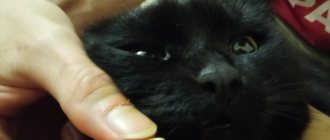Features of the insect
There are different types of fleas, and the choice of remedy depends on what type of insect you encounter. They are divided into:
- Mouse and rat;
- Dogs and cats;
- Sandy;
- Basement, earthen;
- Bedding.
We are interested in cat fleas. How are they different from others, what do they look like? Body length usually ranges between two and five millimeters. The exception is the fertilized female, its length can reach 15 mm. The dark brown body of the insect is densely covered with bristles, which make it easy to move along the animal’s fur.
The main difference between a cat flea and a dog or rat flea is the flattened forehead and close-set eyes.
Why are fleas dangerous?
The main danger of fleas is not the inconvenience it brings to the animal, but the spread of infections. With its bites, a flea can transmit more than 200 types of dangerous diseases. Some of them are dangerous, including for people.
That is why you need to start fighting as soon as possible. The earlier you identify the parasite, the greater the chances of dealing with it with little blood.
Symptoms of infection
It is quite difficult to miss the moment of flea infestation: the animal immediately begins to show anxiety and itch. Swelling and red blisters appear at the bite sites. It’s easy to identify an infestation—just part the animal’s fur and carefully examine the skin. You can also find larvae when combing your pet.
How to detect parasites
Fleas in kittens can only be detected with careful examination or if there are too many parasites, but outwardly the baby may look quite healthy.
Characteristic signs of a kitten being infected with fleas:
- The pet often itches, and he begins to do it very sharply.
- Flea excrement in the form of small black particles or flea eggs can be found on the neck, ears and stomach.
- Non-healing wounds and scratches appear on the animal’s skin.
- The baby is inactive, weak, eats poorly, and loses weight.
- Your pet's fur is falling out.
- The pet sleeps very restlessly.
Important! In particularly advanced conditions, the baby may develop dermatitis, dermatophiliasis and other ulcerative skin lesions.
What are the types of flea treatments for cats?
A veterinarian can help you choose the right effective remedy. If you don’t have time to go to a specialist, you can try to figure it out on your own. Remedies for cat fleas are divided into 7 types:
- Sprays;
- Pills;
- Drops;
- Shampoos;
- Collars;
- Injections;
- Powders.
It is impossible not to highlight folk remedies for which you do not need to buy anything.
Each type of medication has its own pros and cons, based on which you can choose a product individually for your cat.
Sprays
Sprays are sold in special bottles with spray nozzles. Apply the product evenly to the animal's fur, and after the spray has completely dried, comb the cat. It is important not to bathe your cat for two days before use and the same number after. It is advisable to temporarily limit the cat's contact with other animals.
Pills
The tablets act from the inside, so there are no restrictions on bathing and contact.
Despite the fact that drugs in this form have appeared on our market only recently, they are already in demand. The assortment is small. The most ideal option would be Comfortis tablets, suitable for both dogs and cats. The active substance (spinosad) is not toxic to animals. Side effects are completely excluded, provided that the dosage prescribed in the instructions is followed. The substance begins to act in 15-20 minutes, and is completely eliminated from the body after a week.
It is not advisable to repeat the appointment earlier than a month later. It is not recommended to use the tablets for pregnant, debilitated cats or for kittens under 3 months.
Drops
The main advantage of flea drops is that they act as both treatment and prevention. The effect of use usually lasts for a month, so they are convenient to use for animals walking on the street. The principle of application is simple: the number of drops specified in the instructions is applied to the animal’s withers.
It works almost instantly. A good choice would be “4 with a tail” drops, which protect against ticks and fleas. Frontline drops are widely used. They are also considered the best for controlling ticks, mosquitoes and even lice.
Shampoos
Shampoos are suitable only for those owners whose pets are not afraid of water. The product is applied to wet wool, rubbed in until foam appears, and washed off after a while (depending on the composition and indicated in the instructions).
Shampoos vary in degree of toxicity, for example, anti-flea “Leopard” is not dangerous at all, since it contains only herbal ingredients, but with shampoo “Lugovoy” you need to be more careful. It is important to protect the animal's eyes from contact with the product.
Collars
Flea collars are good because they also work to repel insects. They emit a scent that kills those fleas already on the skin and repels all others. The effectiveness of the collar lasts for 6-7 months, after which it needs to be changed. Pros: accessibility, budget, ease of use, efficiency. Cons: toxicity, unpleasant odor, allergic reactions are possible.
Injections
Despite the fact that injections must be done by a veterinarian, many choose them for disinfestation. The injections are effective, provide long-term protection, and also help against fleas and worms at the same time.
The drugs are highly toxic and can cause many side effects. It is recommended to use no more than once every 6 months. Incompatible with other flea products.
Powders
One of the few effective flea treatments that can be used on pregnant cats and even small kittens. Since the product consists of plant components, it is non-toxic and completely safe. Does not cause allergies. The most effective remedy is “Pussy” powder.
Folk remedies
You can remove fleas without resorting to dangerous and toxic chemicals. Traditional medicine will help with this. You need to be prepared for the fact that folk remedies are not so effective and require effort and time. The treatment must be repeated frequently. Most often, wormwood, garlic and essential oils are used to remove fleas.
- Sagebrush. Its smell effectively repels all blood-sucking parasites. To prepare the product you need 20 g of dry or 40 g of fresh leaves. They need to be filled with 500 ml of water and cooked for 15-20 minutes. The cooled mixture is applied to the entire coat. To completely get rid of it, it is worth treating the area and the pet’s bedding.
- Garlic. Fleas are afraid of garlic, which means that it can be used to remove them. 6-7 cloves are crushed and filled with water. Then you need to wait about 12 hours - the product is infused. Apply to the body only in those places that the animal cannot reach. Getting garlic into the gastrointestinal tract is harmful to a cat's health.
Risk factors
The fleas that infect cats live in the grass. From there they jump on warm-blooded animals and feed on their blood. These blood-sucking parasites live on all continents, even Antarctica. A cat can become infected with fleas at any time of the year.
It is important to remember the reasons why a cat is at risk of contracting parasites:
- A cat that goes outside will definitely become infected with fleas. Therefore, you should not let your pet walk on its own.
- Unlike cats, domestic dogs should be walked 2-3 times a day. If a dog brings fleas home, then all other animals will pick them up. All pets should be treated for fleas regularly.
- A person can bring fleas into an apartment on his shoes or outerwear. Only regular treatment with anti-flea products will protect your pet.
- If the cat already had fleas, but the owner did not treat the pet, then the parasites will soon appear again. Fleas lay eggs in animal fur. New parasites can hatch from these eggs at any time.
- Fleas that have already entered the apartment will settle in the thick carpet. All carpets and cat beds should be thoroughly vacuumed.
- Fleas multiply especially actively in the heat, so in the summer you will have to treat your cat several times.
Flea infestations often lead to serious complications that are detrimental to the health of cats. Flea bites always cause severe pain and excruciating itching, and also provoke the development of dangerous diseases.
Complications of flea bites:
- Anemia is a condition in which a cat does not have enough blood due to a large number of parasites. The level of hemoglobin in the blood is greatly reduced. It develops when cats are not treated for fleas. Street animals are most often affected. Very young kittens, as well as weakened, sick and elderly animals can die from anemia.
- Flea dermatitis is an allergic reaction to the saliva of parasites that enters the skin during a bite. The pet experiences severe skin irritation, so the cat constantly licks. Her hair falls out and her skin becomes crusty. Infection easily penetrates damaged skin, which can lead to blood poisoning.
- Infectious diseases - fleas can infect pets with bartonellosis or rickettsia.
- Tapeworms - by licking, a cat can swallow fleas infected with tapeworms. Because of this, worms will begin to multiply in the intestines, the pet’s well-being will worsen, and then it will have to be treated not only for fleas, but also for worms.
Parasites are especially dangerous for pregnant and lactating cats. Fleas can harm not only the mother, but also the future offspring. But during pregnancy and lactation, you cannot treat your cat with anti-flea agents, because they are toxic. Treatment must be carried out before mating.
Up to 200 fleas can live on one cat. A caring owner should treat pets for parasites 4 times a year - every 3 months. If your cat has fleas, you need to carry out additional treatment.
We recommend the article: Bald patches in a cat: how to distinguish normal from pathology?
Safety rules when using the drug
When using insecticidal preparations, it is necessary to follow the rules of personal hygiene and safety precautions. After finishing working with the medicine, you should wash your hands thoroughly with soap.
For people with individual intolerance to the components of the veterinary drug, it is best to use sterile gloves. If adverse reactions occur, you should consult a doctor.
Empty boxes, blisters, and bottles of veterinary medications must be disposed of along with the trash. They cannot be used for household purposes.
Reviews
Svetlana: Bars drops helped my cat get rid of fleas. They were recommended to us by a veterinarian whom we contacted after discovering fleas. You drop it and you can live in peace for two months.
Evgeniy: We regularly buy a Hearts collar for our cat. The result is impressive - fleas do not bother the animal or us. And this despite the fact that we spend the whole summer at the dacha, where the cat walks on its own.
Nina: Our cat loves to walk outside, and in the basement of the house there are cats infested with fleas. From time to time I use flea shampoo. For preventive purposes, in addition to Rolf Club shampoo, I regularly bathe the cat in a decoction of tansy and wormwood, after which I comb out the hair. Fleas don't bother my pet!
Tips before purchasing
If you choose from the above drugs, you can get rid of parasites quite quickly. They will begin to die from the first day of use. But you should still use the drops according to the instructions.
Table. Advantages and disadvantages of the presented funds
| Advantages | Flaws |
|
|
Before using any drug, it is necessary to study contraindications and side effects.
There are no absolute contraindications. The main ones are as follows:
- individual intolerance to the main components of the drug;
- low body weight;
- poor health of the pet caused by infectious diseases or chronic diseases;
- pregnancy or lactation period.
In other cases, these drops can be used without much risk.
Important . It is forbidden to give your cat several flea medications at the same time. They may interact poorly with each other, resulting in the possibility of attacks of nausea, vomiting, and diarrhea. Shortness of breath and twitching of the paws are also possible.
If the animal is quite large, it is recommended to consult a veterinarian. It will help you calculate the optimal dosage. The animal must not be bathed for 3–4 days after applying the drops. Otherwise there will be no beneficial effect.
Anti-flea collars
One of the most popular remedies for animals that “walk on their own.” Collars such as “Barrier” or “Beafar” retain their properties for up to five months. There is no need to worry that your pet will be uncomfortable in the collar: full adaptation takes no more than one or two days, even for adult animals that have never worn a collar before.
The negative points include the following:
- presence of a specific odor;
- Sometimes the hair on the animal's withers thins.
Collars are produced for adult animals and kittens.
Comparison table
| Manufacturer | Animal weight, kg | Volume, ml | Age | Price, rub |
| Hartz | 6-10 | 1,3 | from 3 months | 300 |
| Astrapharm BlochNet max | 4-8 | 1 | from 6 months | 180 |
| Zoetis (Pfizer) | 2,5-4 | 0,25 | from 3 months | 450 |
| Inspector Mini | 2 | 0,4 | from 6 weeks | 323 |
| Beaphar | 2-6 | 400 | from 12 weeks | 580 |
| Celandine | 2-5 | 100 | from 10 weeks | 430 |
| Bars Forte (AVZ) | 2,5-5 | 100 | from 3 months | 500 |
| Agrovet protection Lugovoy | 2,5 | 270 | from 6 weeks | 150 |
| Doctor ZOO | 2,5-6 | 250 | from 10 weeks | 250 |
| Dana Apicenna | 2-4 | 145 | from 12 weeks | 530 |

